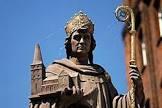
Feast day: 3 February
St Ansgar came from a noble Frankish family born near Amiens. His mother died when he was a boy and he was brought up in the Benedictine monastery of Corbie, in Picardy. According to the Vita Ansgarii (Life of Ansgar), the little boy had a vision of his dead mother in the company of Mary, and this turned him away from his rather casual attitude towards spiritual matters. His pupil and successor, Rimbert, who wrote the Vita, considered the visions which Ansgar experienced - the vision of his mother being the first - to be the main motivator of his life. For some time he taught in the monastic school at Corvey (New Corbie), Westphalia, where he began his pastoral work. He once said to a friend: “One miracle I would, if worthy, ask the Lord to grant me, and that is by his grace, he make me a good man.”
When the exiled Danish King Harald appealed to the Carolingian Emperor, Louis the Pious, for support, Louis sent Ansgar to accompany and assist the king in evangelising Denmark. He began his mission in Schleswig in 826; it was however short-lived, due to Harald’s downfall, and after three years he returned home. He then went to Sweden at the invitation of King Bjorn. On the way his boat was attacked by pirates and he lost all his possessions. He arrived destitute in a small Swedish village. He was the first to preach the gospel in Sweden, and built the first Christian church. Ansgar believed from a vision he had that he was called to this mission. He was informed that he would meet a prophet, the abbot Adalhard, who would instruct him as to what was to happen. In the vision he met Adalhard who commanded: “Islands, listen to me; pay attention, remotest peoples.” Ansgar interpreted this as God’s will that he go to the Scandinavian countries, as most of them consisted of islands. Aditionally, Christ’s command that the gospel be preached to the “ends of the earth” suggested to him Swedish territory,since the end of the world in the north was there. Ansgar preached and made converts, particularly during the six months at Birka, on Lake Malaren. Ansgar organized a small congregation there with the help of a wealthy widow.
In 831 Ansgar returned to Louis’ court at Worms and was appointed to the archbishopric of Hamburg-Bremen. This was a new archbishopric which incorporated the sees of Bremen and Verdun. It had the right to send missions to all the northern lands, as well as to Norway and Sweden. Ansgar was given the task of evangelising Denmark, Sweden and Norway. The King of Sweden decided to cast lots as to whether to admit the missionaries, but after Ansgar prayed the lot was favourable. Ansgar was consecrated as a bishop with the approval of Pope Gregory IV, and went to Rome to receive the pallium from him. The jurisdiction was divided between himself and the Archbishop of Reims who received Sweden. For a time Ansgar attended to his own diocese which was still missionary territory and had few churches. He founded a monastery and a school in Hamburg. This was intended to serve the Danish mission further north but accomplished little.
In 840 Louis the Pious died and his empire was divided into three. Ansgar lost the abbey of Turholt, near Bruges in Flanders, which Louis had given him to endow Asgar’s work. Then in 845 the Danes raided Hamburg, destroying all the church’s treasures and books. The new king assigned Ansgar to the see of Bremen, to which Ansgar moved in 848. However because Bremen had been suffrogen to the Bishop of Cologne, combining the sees of Bremen and Hamburg posed difficulties. This was resolved by Pope Nicholas I who approved the union in 864.
Ansgar continued his northern mission, maintaining good relations with the kings of Denmark who assisted him till his death. Ansgar was allowed to build a church at Sleswick, north of Hamburg, and Christianity was recognized as a tolerated religion. He spent two years in Sweden from 848-850 averting a pagan reaction. In 854 he returned to Sweden where the king was well disposed towards Christianity.
Ansgar died in 865. His biographer, Rimbert, noted that he lived an ascetic life: he wore a hairshirt, lived on bread and water and showed great charity to the poor. He is said to have written a book of prayers, Pigmenta. He had to contend with much of his work being destroyed, and after his death the area reverted to paganism. Pope Nicholas I declared him a saint soon after his death. He was later declared Patron of Scandinavia. His relics are housed in two churches in Hamburg, St Mary’s cathedral and the church of SS Ansgar and Bernard. Scandinavia would not become Christian till its reconversion under Harald Bluetooth and St Siegfried.
St Ansgar, missionary to Scandinavia, pray for us.